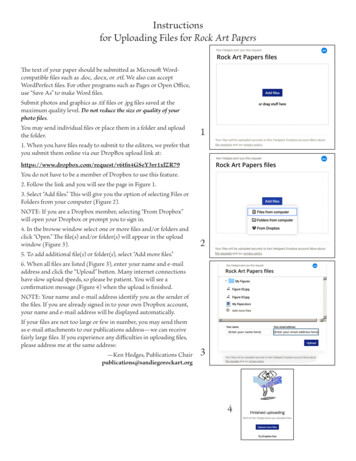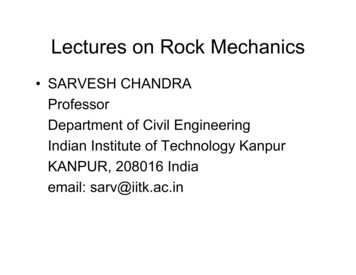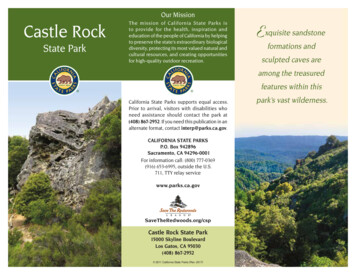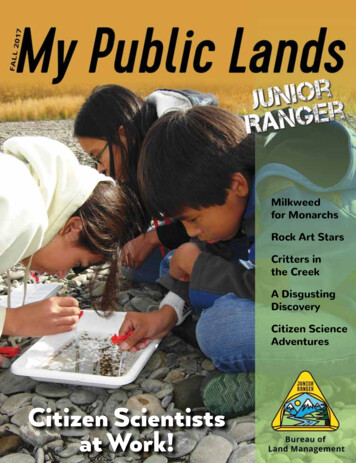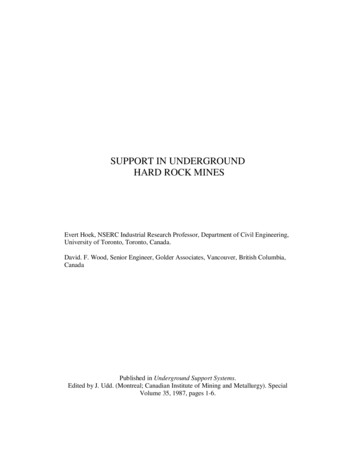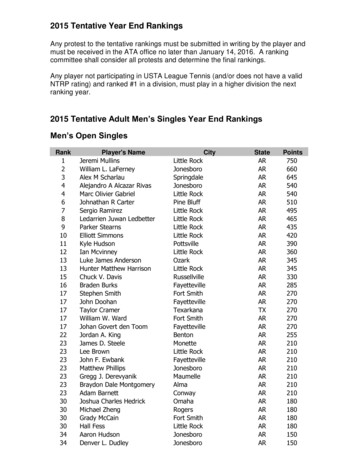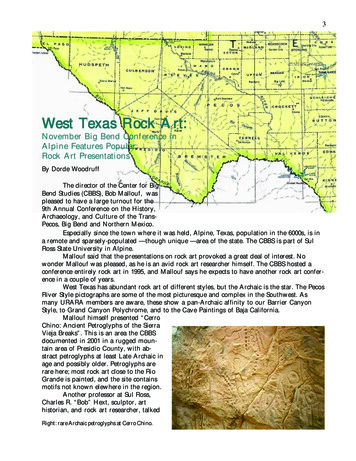
Transcription
3West Texas Rock Art:TexasNovember Big Bend Conference inAlpine Features PopularRock Art PresentationsBy Dorde WoodruffThe director of the Center for BigBend Studies (CBBS), Bob Mallouf, waspleased to have a large turnout for the9th Annual Conference on the History,Archaeology, and Culture of the TransPecos, Big Bend and Northern Mexico.Especially since the town where it was held, Alpine, Texas, population in the 6000s, is ina remote and sparsely-populated —though unique —area of the state. The CBBS is part of SulRoss State University in Alpine.Mallouf said that the presentations on rock art provoked a great deal of interest. Nowonder Mallouf was pleased, as he is an avid rock art researcher himself. The CBBS hosted aconference entirely rock art in 1995, and Mallouf says he expects to have another rock art conference in a couple of years.West Texas has abundant rock art of different styles, but the Archaic is the star. The PecosRiver Style pictographs are some of the most picturesque and complex in the Southwest. Asmany URARA members are aware, these show a pan-Archaic affinity to our Barrier CanyonStyle, to Grand Canyon Polychrome, and to the Cave Paintings of Baja California.Mallouf himself presented “CerroChino: Ancient Petroglyphs of the SierraVieja Breaks”. This is an area the CBBSdocumented in 2001 in a rugged mountain area of Presidio County, with abstract petroglyphs at least Late Archaic inage and possibly older. Petroglyphs arerare here; most rock art close to the RioGrande is painted, and the site containsmotifs not known elewhere in the region.Another professor at Sul Ross,Charles R. “Bob” Hext, sculptor, arthistorian, and rock art researcher, talkedRight: rare Archaic petroglyphs at Cerro Chino.
4about the rock art of Jeff Davis County northwestof Alpine. Hext is involved in a rock art survey ofthe Trans-Pecos area.Going to the other end of the archeologicalage spectrum, Dawn Temple talked about “SanSebastian: Probable Apache Rock Art in the MarfaPlain of the Texas Big Bend.” Dawn is a geologystudent at Sul Ross who also studies rock art andrecords it.Texas artist turned rock art researcherReeda Peel presented three poster sessions. “AnOverview of Texas Rock Art” described traditionsor styles recognized in the state, as well as rock artyet to be defined, correlated with a map of thenatural regions of Texas. She also presented this at the ARARA symposium in 2002.Her poster session “Tradition or Style . What’s the Difference?” was on usage of theseterms, illustrated with examples of the state’s rock art. And “Rocky Dell.Chasing the Myth”was about a so-called giant serpent pictograph that really looks more like a lizard, which sherelated to the myth of Earth Monster.Reeda does wonderful intrepretations of ancient life with rock shelter art on the wallsbehind the figures, based on careful archeological research, see her Girl with Fire Drill above.Here’s an artist that’s really gotten into rock art: she’s a charter member of the Texas Archaeological Society Rock Art Recording Task Force, a TAS board member, and a steward for the stateHistorical Commission.“Unusual Rock Art of the Texas Panhandle” was the title of Teddy Lou Stickney’s talk.Teddy is the head of the TAS Rock Art Recording Task Force that each year concentrates on anarea in which to thoroughly document the rock art. Teddy is also the new president of ARARA.Teddy and Francis Stickney were the honorees of the 2002 annual publication of the New MexicoArchaeological Society, Looking Forward to the Past.Solveig Turpin, a founder of the Rock ArtFoundation and authority on Pecos River Style, andher son Jeff gave a paper entitled “Under Every Rock:Prehistoric Utilization of a High Desert Ecozone inWest Texas” in which “rock art was incidental . thearticle in this year’s Journal of Big Bend Studies [“RockArt in Isolation: The Black Mountains and Red HIlls ofHudspeth County”] gave a much more in-depthdescription of what we found in these isolated enclaves (Turpin, email comunication 2002).” TheCBBS’s Journal is a combination of symposium papersand other contributed papers; URARA has now set upan exchange of publications with them.The strictest interpretation of the geographicalmandate of the Center is the Big Bend country, theTrans-Pecos, and adjacent northern Mexico. TransPecos is “Beyond the Pecos”, west of the Pecos River.Remember Judge Roy Bean, the “Law West of thePecos”, the only judge that ever, despite his quirks,A shaman in Rattlesnake Canyon which runs several miles then joinsthe Rio Grande. He is especially reminscent of our Barrier Canyonfigures.
5A family group approaches Fate Bell Shelter in a scene envisioned by Reeda Peel. These people probably lived in smallfamily groups, joining up with others on occasion.lasted out there in the frontier wilderness of this still-remote area? However, for the conference orpublications they don’t limit themselves to the Trans-Pecos and northern Chihuahuan region, butrather consider the Lower Pecos River Region and other areas of West Texas (including the TexasPanhandle), southeastern New Mexico, and northern Coahuila to all be areas of interest.The Lower Pecos region centers roughly on the lower parts of the Pecos and Devils rivers,as they flow south to join the Rio Grande, now flooded near those confluences by the Amistadreservoir. Pecos River Style pictographs extend about 90 miles north from the Rio Grande, andalso about 90 miles south to the mountains of Coahuila, skipping the barren plains south of theRio Grande. There is some Pecos River Style art west of the Pecos for a short distance, but more ofit east along the lower Devil’s River. East to west, it goes about from Del Rio to Langtry.Carolyn Boyd of Texas A&M, another active rock art researcher of the area and artistturned-archeologist, thinks these images were components of large, mural-like compositions, andcompares them to her experience as a mural painter and to the myths and practices of theHuichol who still live across the Great River in northern Mexico.Tours go to quite a few sites now, but getting to the wilder sites she says can be an ordeal,“Some of them are in really remote areas. You drive an hour down a dirt road then hike in a fewmiles over rugged terrain. They are in some cases up on canyon walls, and you have to rappeldown to them.there’s real danger in accessing some of the sites.” She thinks some were deliberately placed in difficult places, “some.were for select groups.”When Jim and I drove through Texas about ten years ago, there were no handy websitesfor information. We stopped at the Seminole Canyon State Park in the Pecos area on a Mondaybut were frustrated to be told that the tour, to Fate Bell Shelter, only went Wednesday throughSunday, and only on a tour is visiting the rock art permitted.Now two websites, especially, list all the tours, from the Rock Art Foundation atwww.rockart.org/journey.html and www.rockart.org/calendar.html, and from Texas Park andWildlife at www.tpwd.state.tx.us/news/tpwcal/s 0148.htm.TPWD has a website for Seminole Canyon, www.tpwd.state.tx.us/park/seminole/, forDevil’s River State Natural Area, www.tpwd.state.tx.us/park/devils/, and for Big Bend RanchState Park adjacent to the Big Bend National Park, new and undeveloped, seewww.tpwd.state.tx.us/park/bigbend/The Handbook of Texas Online has a number of short articles for various rock art sites, see
6the archeology index at www.tsha.utexas.edu/handbook/online/browse/wt aeol.html forsubjects like Indian Rock Art; Kirkland, Olea Forrest; Trans-Pecos; Fate Bell Shelter; Lobo Valley;Panther Cave; Rattlesnake Canyon.Texas Beyond History is an outstanding website, a joint project of the Texas ArcheologicalResearch Laboratory (TARL) at The University of Texas at Austin and the Texas ArcheologicalSociety. The section on the Lower Pecos begins at www.texasbeyondhistory.net/pecos/index.html. Lavishly illustrated, it’s edited by Steve Black, a Research Associate at TARL, Lecturer in Anthropology at the University of Texas, and an experienced archeologist in Texas,Mesoamerica, and the Southwest.What of those members who are not online? Several books cover the Lower Pecos:Kirkland, Forest and W.W. Newcomb, Jr.1999 The Rock Art of Texas Indians. Reprint of the classic. University of Texas Press, Austin.Amazon, 34.95; Piedra Pintada, see www.rock-art.com/books/krklnd1.htm, 35.Mallouf , Robert J. and Curtis Tunnell1977 An Archeological Reconnaissance in the Lower Canyons of the Rio Grande. Texas HistoricalCommission, Austin. Out of print; we’ve obtaind this for our URARA Archives.Shafer, Harry J. and Jim Zintgraff1986 Ancient Texans: Rock Art and Lifeways along the Lower Pecos. Texas Monthly Press, Austin.Excellent popular book now out of press, available from amazon.com for 225 and up!Smith-Savage, Sheron and Robert J. Mallouf, eds1998 Rock Art of the Chihuahuan Desert Borderlands. Occasional Paper No. 3. Sul Ross StateUniversity, Alpine, Texas. Proceedings of the First Trans-Pecos Rock Art Symposium, February 17-19, 1995. Piedra Pintada, 20; we’ve also gotten this for the URARA Archives.Turpin, Solveig A., ed1994 Shamanism and Rock Art in North America. Rock Art Foundation, San Antonio. RAFor Piedra Pintada, 20. “A superb book that expands on the further possibilities of the rockart images .”Zintgraff, Jim and Solveig A. Turpin1991 Pecos River Rock Art: A Photographic Essay. S. McPherson, San Antonio. Amazon, 43.70;Piedra Pintada, 45; Side Canyon, 36.95, RAF 36. Zintgraff spent decades photographingPecos rock art, and Turpin years studying it.And a CD-ROM:Turpin, Solveig A. and Jim Zintgraff2002 Rock Art of the Lower Pecos. RAF, 40 incl S&H, see www.rockart.org/cdrom.html fordescription.Source contact information is: Piedra Pintada rock art books, www.rock-art.com/books/index.htm, call 909/620-6742, or write Bob Edberg, Piedra Pintada Books, P.O. Box 1376,Claremont CA 9171; Side Canyon Southwestern books, maps, videos, http://sidecanyon.com, orcall 866-775-8336The official Texas travel site www.traveltex.com has lots of features including a wholesection on the Big Bend country, or call 800-452-9292.Going on to the Big Bend, Big Bend National Park has what is surely the most outstandingwebsite of the National Parks, with dozens of pages; see the alphabetical list of topics atwww.nps.gov/bibe/alpha.htm or “In depth” at www.nps.gov/bibe/home.htm. This park hasthe fewest visitors per mile of any in the U.S. Foreign visitors such as Germans and Japanese whoalways go for the most exotic, especially if it includes those weird plants, cacti, love it, and comprise a substantial part of the visitors. Summers are hot, but the average daytime maximum inJanuary is 60 degrees!Rock art in the park (and the adjoining Big Bend Ranch State Park) has never been wellsurveyed though people have worked there for decades. The CBBS has been working on anarcheological survey there since 1995, but funding is minimal, therefore progress is slow.The park includes desert, mountain, and 118 miles of the Rio Grande in its 801,000 acres,
7therefore has a great diversity of plants and animals in its Chihuahuan desert biome. No wonderit was home to Native Americans from Paleoindian times on.In Utah we sometimes visit rock art from the rivers, especially the Green in DesolationCanyon, the San Juan, and in former times the late lamented Glen Canyon of the Colorado.Another way to see West Texas rock art is on the rivers, either on a private trip or with an outfitter. Canoeist Louis Aulbach is the author and publisher of Texas River Guides: The Devil’s River,The Lower Pecos River, The Upper Canyons of the Rio Grande,The Great Unknown of the Rio Grande, and The PaintedCanyons of the Rio Grande.Also linked from his website www.hal-pc.org/ lfa/ is river flow information. Or contact Louis F.Aulbach, P. O. Box 925765, Houston TX 77292-5765.You can access another series of river webpagesfrom http://canoeman.com/SWPaddler/Texas.html, fordescriptions of trips down the Pecos, Devil’s, or RioGrande. And see Big Bend National Park webpages onriver runing, also many others.However, these trips need to be done with adequate information and great care. Some stretches haverapids requiring portages, hazards fluctuate with thewater level, like our rivers they are remote, and in Texasthere is an additional hazard: private land. Especially onthe Devil’s, landowners can be hard on trespassing campers.However, our member Ben Everitt ran the LowerCanyons of the Rio Grande some years ago, between BigBend National Park and Amistad Reservoir, and hesays it was “the trip of a lifetime.and I’d do itagain.” Canoeman River Guide Services will plantrips, to any degree requested, phone 214-221-1290if you don’t have email access.For the landlocked, the huge Big Bend parkhas 112 miles of paved roads, and over 150 miles ofunpaved roads with various hazards including thepossibility of punctured tires from those yucca tipsthat are like spears, or other hostile desert vegetation.Despite an estimated 10,000 archeologicalsites in Big Bend National Park, only two rock artsites are considered public. The Hot Springs pictograph site is easily reached by a short drive fromthe Rio Grande Village visitor center on the eastside of the park. And on the west side, there’s rockart around the bases of the Chimneys, prominentlandmarks 2.4 miles from the trailhead at a primitive campsite off Maverick road, which is a gravelroad that is generally passable.Western Texas, especially along the RioGrande at Big Bend or Seminole Canyon, is a greatRight, above: Detail, White Shaman Shelter. Below, The WhiteShaman. Tom Getts.
8winter trip. The south side of Big Bend is about as far south as Daytona Beach, Florida! Despiteits attractions, with these sites being so far away, a trip to Texas isn’t to be taken lightly. SeminoleCanyon is about 1200 miles from Salt Lake. Members living in other places may have lightergoing – our webmaster Tom Getts has been to White Shaman half a dozen times. But then, hestarts from Mancos in far southwestern Colorado.The Pecos River Style attacts much attention these days, but the Jornado Mogollon style ofHueco Tanks is up to now more familiar to most URARA members. References to the CasasGrande influence, and Texas rock art styles other than the Archaic can be found on some of thesewebsites, or in the many printed sources for information on these subjects.Some other websites of interest:Tom Gett’s Pecos River Style rock art photos from White Shaman Shelter, Panther Cave, MysticShelter, and Cedar Springswww.canyonwinds.com/rockart/index.htmlThe RAF’s James Zintgraff’s own page of a few high-quality Pecos e.htmlForrest Kirkland’s Watercolors of Texas Rock Art, a site of the Texas Memorial Museum featuringa large number of original paintings.www.tmm.utexas.edu/anthro/kirkland/And some more print references:Boyd, Caroline1996 Medicinal and Hallucinogenic Plants Identified in the Sediments and Pictographsof the Lower Pecos, Texas Archaic. Antiquity 70 (268, June).Turpin, Solveig1990 Rock Art and Its Contribution to Hunter Gatherer Archaeology: A Case Studyfrom the Lower Pecos River Region of Southwest Texas and Northern Mexico.Journal of Field Archaeology 17(3):263-281.1990 Speculations on the Age and Origin of the Pecos River Style. American IndianRock Art 16:99-122.1991 Sin Nombre and El Fortin: Pecos River Style Pictographs in Northern Mexico.Bulletin of the Texas Archeological Society 60:267-281 (for 1989).1994 The Were-Cougar Theme in Pecos River Style Art and its Implications forTraditional Archeology. In New Light on Old Art: Recent Advances in Hunter-GathererRock Art Research, edited by David S. Whitley and Lawrence L. Loendorf, pp. 75-80.Monograph 36, Institute of Archaeology, University of California, Los Angeles.Turpin, Solveig, ed.2002 Rock Art and Cultural Processes. Rock Art Foundation, San Antonio. Their latestspecial publication, with outstanding essays by Linea Sundstrom, Polly Schaafsma,Kelley Hayes-Gilpin, Bill Hyder, and Solveig Turpin. 15 5 S&H.CreditsThanks to these people for the graphics, used with permission: Map of W. Texas counties,courtesy of The General Libraries, The University of Texas at Austin. Cerro Chino, Bob Maloufand the CBBS. Girl with Fire Drill and Fate Bell Shelter, Reeda Peel and Texas Beyond History.Rattlesnake Canyon, Steve Black and Texas Beyond History. White Shaman Shelter, Tom Getts.Thanks to Drs. Robert Mallouf and Solveig Turpin for information via email.
Ross State University in Alpine. Mallouf said that the presentations on rock art provoked a great deal of interest. No wonder Mallouf was pleased, as he is an avid rock art researcher himself. The CBBS hosted a conference entirely rock art in 1995, and Mallouf says he expects to have another rock art confer-ence in a couple of years.
